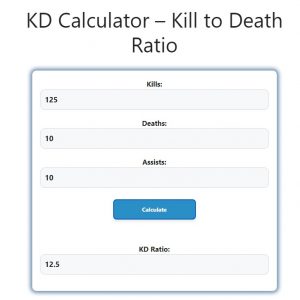About KD Calculator (Formula)
The Kill to Death ratio (KD ratio) is a popular metric in gaming, especially in first-person shooters and battle royale games, used to measure a player’s performance. The KD ratio is calculated by dividing the number of kills by the number of deaths. A higher KD ratio indicates better performance, reflecting a player’s ability to eliminate opponents while staying alive. Our KD Calculator simplifies this calculation, helping gamers quickly determine their KD ratio.
Formula
The formula to calculate the KD ratio is:
KD Ratio = Number of Kills / Number of Deaths
How to Use
- Enter the Number of Kills: Input the total number of kills you have achieved in the game.
- Enter the Number of Deaths: Input the total number of times you have died in the game.
- Calculate the KD Ratio: The calculator will divide the number of kills by the number of deaths to give you your KD ratio.
Example
Suppose a player has achieved 125 kills and has died 10 times in a game. Using the KD ratio formula:
KD Ratio = 125 kills / 10 deaths = 12.5
This means the player has a KD ratio of 12.5, indicating that for every death, they have eliminated 12.5 opponents on average.

FAQs
- What is a good KD ratio?
- A KD ratio of 1.0 means you have an equal number of kills and deaths. Anything above 1.0 is considered above average, with higher values indicating better performance.
- Does the KD ratio include assists?
- Traditionally, the KD ratio does not include assists; it only accounts for kills and deaths. However, some games may track and display a separate “KDA” ratio (Kills, Deaths, Assists).
- Can the KD ratio be negative?
- No, the KD ratio cannot be negative. It ranges from 0 upwards, depending on the number of kills relative to deaths.
- How can I improve my KD ratio?
- Improving your KD ratio involves enhancing your gameplay skills, such as better aiming, strategic positioning, and learning from each match to minimize deaths and maximize kills.
- Is a high KD ratio important in all games?
- While a high KD ratio is often seen as a sign of skill, its importance varies depending on the game. In team-based games, contributing to objectives may be more valuable than a high KD ratio.
- What happens if I have zero deaths?
- If you have zero deaths, your KD ratio would technically be undefined (division by zero). However, some calculators may display it as the total number of kills, representing a perfect game.
- Can the KD ratio fluctuate during gameplay?
- Yes, your KD ratio can change throughout a match or over multiple games as you accumulate more kills and deaths.
- Why do some players focus heavily on their KD ratio?
- Many players use the KD ratio as a personal benchmark to track their improvement and competitiveness in the game.
- Does a low KD ratio mean I’m a bad player?
- Not necessarily. A low KD ratio could be due to playing against tougher opponents, trying new strategies, or focusing on team objectives rather than individual kills.
- How does the KD ratio affect matchmaking?
- In some games, a player’s KD ratio might influence matchmaking, pairing them with opponents of similar skill levels to maintain balanced gameplay.
- Is KD ratio the only metric for assessing player skill?
- No, the KD ratio is just one of many metrics. Other factors like objective captures, assists, and overall contribution to the team can also reflect a player’s skill.
- Can the KD ratio help in understanding playstyle?
- Yes, a high KD ratio may indicate an aggressive playstyle, while a lower KD ratio could suggest a more supportive or objective-focused approach.
- Does the KD ratio reset with each game?
- The KD ratio is typically cumulative across matches in many games, but some games may track it on a per-match basis as well.
- How does the KD ratio compare to other performance metrics?
- The KD ratio is a straightforward measure of kills versus deaths, while other metrics might consider factors like damage dealt, healing provided, or time spent on objectives.
- Is it possible to have a KD ratio below 1.0?
- Yes, if you have more deaths than kills, your KD ratio will be below 1.0, indicating that you’re dying more often than eliminating opponents.
- Why do some players focus more on KD ratio than winning?
- Some players prioritize KD ratio as a personal challenge or to showcase their individual skill, even if it doesn’t always lead to a team victory.
- Can the KD ratio be applied to non-shooter games?
- While most common in shooters, the KD ratio concept can be adapted to any game where kills and deaths are tracked.
- How does the KD ratio affect player rankings?
- In some games, a high KD ratio can contribute to higher rankings, but other factors like win/loss records and match performance also play a role.
- What is KDA, and how is it different from KD ratio?
- KDA stands for Kills, Deaths, Assists. It’s a more comprehensive metric that includes assists alongside kills and deaths, giving a broader view of a player’s impact.
- Can KD ratio be a team-based metric?
- Typically, KD ratio is an individual metric, but in team-based games, teams may track an average KD ratio to gauge overall performance.
Conclusion
The KD ratio is a fundamental metric in the gaming world, providing a quick snapshot of a player’s combat effectiveness. Whether you’re aiming to improve your skills or just curious about your performance, our KD Calculator makes it easy to calculate and understand your KD ratio. Remember, while a high KD ratio can be impressive, focusing on overall gameplay and team contributions is equally important for success.
Related:
